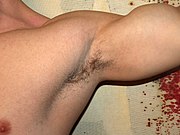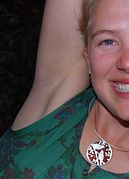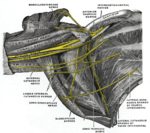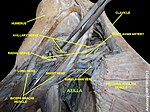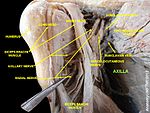Axilla
This article needs additional citations for verification. (November 2007) |
| Axilla | |
|---|---|
 Deep muscles of the chest and front of the arm, with the boundaries of the axilla. | |
| Details | |
| Artery | axillary artery |
| Vein | axillary vein |
| Nerve | axillary nerve, medial cord, posterior cord, lateral cord |
| Lymph | axillary lymph nodes |
| Identifiers | |
| Latin | Axilla |
| MeSH | D001365 |
| TA98 | A01.1.00.021 |
| TA2 | 140 |
| FMA | 24864 |
| Anatomical terminology | |
The axilla (or armpit, underarm, or oxter) is the area on the human body directly under the joint where the arm connects to the shoulder. It also provides the under-arm sweat gland.
Boundaries
Anatomically, the boundaries of the axilla are:
| superiorly: by the outer border of first rib, superior border of scapula, and posterior border of clavicle[[#cite_note-titleAnaesthesia_UK_:�AnaesthesiaUK:_Applied_anatomy_for_upper_limb_blocks-1|[1]]] | ||
| medially: serratus anterior [2] and by the ribcage | anteriorly: by the pectoralis major, minor,[3] and subclavius [2] (see also anterior axillary fold)
posteriorly: by the subscapularis above, and teres major and latissimus dorsi below[2] (see also posterior axillary fold) |
laterally: by the intertubercular sulcus [3] (coracobrachialis and the short head of the biceps brachii are in the axilla.)[2] |
| floor/base: by the skin[[#cite_note-titleAnaesthesia_UK_:�AnaesthesiaUK:_Applied_anatomy_for_upper_limb_blocks-1|[1]]] (visible surface of armpit) |
The contents of the axilla include the axillary vein and artery, as well as the brachial plexus, lymph nodes and fat. Axilla is the space between the side of the thorax and the upper arm.
Contents of the axilla
1.Axillary artery and its branches. 2.Axillary vein and its branches. 3.Infraclavicular part of the brachial plexus. 4.Five groups of axillary lymph nodes and the associated lymphatics. 5.The long thoracic and intercostobrachial nerves. 6.Axillary fat and areolar tissue in which the other contents are embedded.
Terminology
The term "underarm" typically refers to the outer surface of the axilla. However, the terms are sometimes used interchangeably in casual contexts. Colloquially, armpit refers to an object or place which is smelly, greasy, hairy or otherwise undesirable.[4]
The term oxter is most often used in the United Kingdom [5] and the Republic of Ireland. In Northern Ireland "oxter" generally replaces all other names for the armpit.
Underarm hair
Underarm hair usually grows in the underarms of both females and males, beginning in adolescence. In some modern Western cultures, it is common for women to remove underarm hair for aesthetic reasons. As underarm hair grows quickly, shaving must be performed frequently, or else stubble will appear in the axilla.
Throughout the feminist movement, previously in the hippie culture, and in some areas of the punk rock scene, some women choose to keep their underarm hair for a variety of reasons, from subversion to egalitarianism to comfort. Conversely, some men choose to remove their underarm hair for similar aesthetic reasons or to reduce friction in some sports, such as swimming.
Axillary intertrigo
Excessive perspiration can result in axillary intertrigo. Intertrigo is an inflamed skin condition caused by heat, friction, and moisture.[6] A warm, wet armpit may accommodate the growth of pathogenic bacteria, yeasts, and fungi.[7] The condition is responsible for rash-like symptoms, pustules, or chronic itching or burning in the armpit.[6] Axillary intertrigo is common among those who work in hot environments.[7]
Miscellany

- The axilla is one of the four sites (the other three being the mouth, rectum, and ear canal) in which a medical thermometer may be inserted in order to measure body temperature.
- The underarms are among the locations in the human body which are most vulnerable to tickling.
- The use of the armpit during sexual activity is called axillism.[8]
Gallery
-
Superficial muscles of the chest and front of the arm.
-
Axillary artery and its branches - anterior view of right upper limb and thorax.
-
The veins of the right axilla, viewed from in front.
-
The right brachial plexus (infraclavicular portion) in the axillary fossa; viewed from below and in front.
-
The left side of the thorax.
-
Axilla
-
Axilla
See also
- Popliteal fossa or "knee pit"
Notes
- ^ [[#cite_ref-titleAnaesthesia_UK_:�AnaesthesiaUK:_Applied_anatomy_for_upper_limb_blocks_1-0|a]] [[#cite_ref-titleAnaesthesia_UK_:�AnaesthesiaUK:_Applied_anatomy_for_upper_limb_blocks_1-1|b]] [http://www.anaesthesiauk.com/article.aspx?articleid=100359 "Anaesthesia UK :�AnaesthesiaUK: Applied anatomy for upper limb blocks"]. Retrieved 2007-12-23.
{{cite web}}: replacement character in|title=at position 17 (help) - ^ a b c d "LAB #4 PECTORAL REGION & Introduction to the Axilla". Retrieved 2007-12-23.
- ^ a b "Dissector Answers - Axilla and Arm". Archived from the original on 2007-12-10. Retrieved 2007-12-23.
- ^ "Definition of armpit - Merriam-Webster Online Dictionary". Retrieved 2007-12-23.
- ^ "BBC - Voices - Multilingual Nation". Retrieved 2007-12-23.
- ^ a b Selden, Samuel, MD. Intertrigo. emedicine, WebMD. March 9, 2007. Accessed May 21, 2009.
- ^ a b Occupational Dermatoses - A Program for Physicians. National Institute for Occupational Safety and Health. April 17, 2001. Accessed May 21, 2009.
- ^ John Baxter (10 February 2009). Carnal Knowledge: Baxter's Concise Encyclopedia of Modern Sex. HarperCollins. p. 17. ISBN 978-0-06-087434-6. Retrieved 24 December 2011.
External links
- Step by step Video dissection of the Human Axilla showing all relevant anatomy
- 3D animated overview of axillary anatomy (rich media)
- Template:EMedicineDictionary
- lesson3axilla at The Anatomy Lesson by Wesley Norman (Georgetown University)
- lesson3axillarywalls at The Anatomy Lesson by Wesley Norman (Georgetown University)

